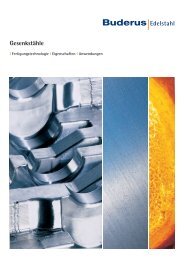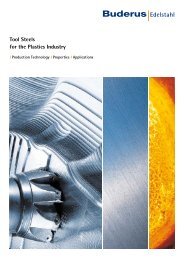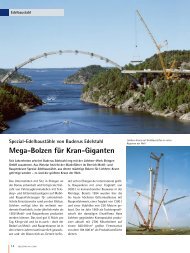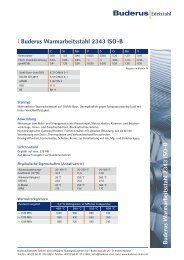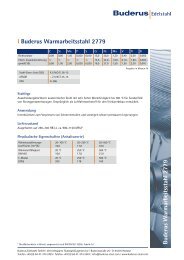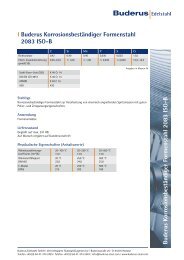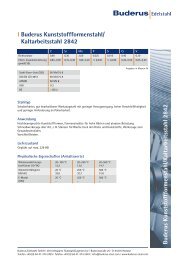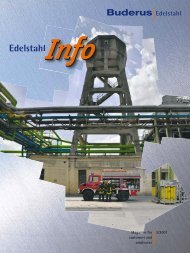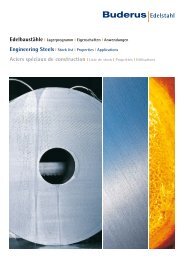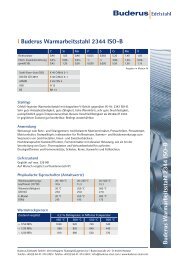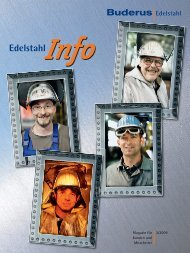Die Steels - Buderus Edelstahl Gmbh
Die Steels - Buderus Edelstahl Gmbh
Die Steels - Buderus Edelstahl Gmbh
Create successful ePaper yourself
Turn your PDF publications into a flip-book with our unique Google optimized e-Paper software.
<strong>Die</strong> <strong>Steels</strong><br />
I Production Technology I Properties I Applications
<strong>Buderus</strong> <strong>Edelstahl</strong> – The Specialist for <strong>Die</strong> Steel<br />
State-of-the-art metallurgy<br />
and forging technology<br />
55 MN open die forging press, finish forging of 1400x750x8500 mm die block weighing 70 tonnes<br />
Customized steels and<br />
mould parts for<br />
manufacturing dies<br />
• Producing high purity electric steel<br />
melts using secondary and vacuum<br />
metallurgical processes<br />
• Producing tool steels of <strong>Buderus</strong> ISO-B<br />
quality, i.e. special melts with extremely<br />
low sulfur content and high percentage<br />
purity<br />
• Bottom ingot pouring and special hood<br />
type plant for making low-segregation<br />
raw ingots<br />
• Hot forming using programmed forging<br />
sequences for ingots up to 150 tonnes<br />
and a maximum forging weight of 80<br />
tonnes<br />
• All heat treatment processes in continuous<br />
furnaces, bogie hearth furnaces<br />
and batch furnaces and under protective<br />
gas, vacuum atmosphere with<br />
compressed gas tempering and salt<br />
bath hardening<br />
• Efficient machining to customer<br />
specification and drawing<br />
• Stocking the complete range of tool<br />
steels, round, square and flat,<br />
immediate delivery ex stock<br />
• Blanks split longitudinally or across:<br />
Prompt delivery from material in stock<br />
• Custom heat treating, including post<br />
rough machined moulds<br />
Forging round bar on the<br />
55 MN open die forging press Annealing Individually heat treated disks for die inserts
• Rough machining<br />
• Full service in-house technical<br />
resources to assist with questions<br />
regarding material selection, heat<br />
treatment or die design.<br />
• Assistance with developing new<br />
dies and die materials for special<br />
requirements<br />
• Failure analysis assistance, with<br />
objective enhanced tool life<br />
recommendations<br />
Fully automatic 80 MN closed-die forging press<br />
Truck steering knuckle die insert Truck steering knuckle blank
The material concept<br />
The right material for all<br />
application profiles<br />
Optimal use of a die steel is closely linked to understanding its stress<br />
profile (Figure 1). The right die steel for forging-die and press-die<br />
units and secondary tools is selected bearing in mind economic<br />
and qualitative aspects. One major factor is the die’s service life<br />
or estimated tool life quantity (see Tables 1 and on page 8). The<br />
tool life quantity is generally limited by wear, or by cracking in the<br />
case of complicated impressions (see Table 1 on page 8+9).<br />
<strong>Die</strong> wear is significantly reduced as the alloy content of carbide<br />
formers such as vanadium, molybdenum, tungsten and chromium<br />
is increased, as shown in Figure . One qualitative measure of this<br />
is the alloy coefficient (AC) used to rate steel. Higher-grade steels<br />
produce favourable results when an optimum relationship between<br />
tool life quantity and tool costs is achieved.<br />
The tool life quantity can be further optimized by increasing hardness,<br />
balanced with the necessary toughness characteristics. Key<br />
here is uniform quenching and tempering of the dies throughout<br />
their cross-section. Comparing the hardness distribution of the<br />
standard die steel 2714 ISO-B to the recently developed new die<br />
steel 2714ISO-Bmod. confirms this modified composition improves<br />
hardening and tempering characteristics (see Figure and Table<br />
on page 10).<br />
Figure 1<br />
<strong>Die</strong> tool stress profile<br />
Mechanical<br />
stress<br />
Thermal<br />
stress<br />
Mechanically induced<br />
state of tension<br />
Mechanical die load<br />
Relative movement<br />
die/forging<br />
Deformation • Cracking • Fracture<br />
Wear • Deformation • Temperature fatigue cracking<br />
Thermally induced<br />
state of tension<br />
Thermal die load<br />
Loss of cohesion<br />
Matched material characteristics<br />
ensure high tool life quantities<br />
This special steel is effective for forging dies with high volumes,<br />
regardless of the die size and impression depth.<br />
Heat resistance and hardness retention are key material indicators<br />
for die steels. Loss of hardness and even transformation of the<br />
microstructure at the impression surface is the most frequent cause<br />
of wear, deformation and cracking.<br />
Figure 2<br />
Effect of alloy content on die wear<br />
<strong>Die</strong> wear (µm)<br />
µm<br />
350<br />
300<br />
250<br />
200<br />
150<br />
100<br />
50<br />
2713<br />
2714<br />
2744<br />
2714mod.<br />
2766<br />
2343<br />
2606<br />
2365<br />
2344<br />
2367<br />
Temperature 250°C<br />
Alloy coefficient<br />
2Cr + 5W + 10Mo + 40V<br />
0<br />
0 10 20 30 40 50 60 70 80 90 100 110 120<br />
Alloy coefficient
<strong>Die</strong> steels can be divided into two groups according to their tempering<br />
behaviour as illustrated in Figure :<br />
Group 1<br />
The low hardness retention of these nickel alloy steels makes<br />
them unsuitable for applications involving high temperature load<br />
(> 500 °C) with relatively long or frequent contact phases, as for<br />
example in presses.<br />
Group 2<br />
These steels are much more resistant to thermal load than those<br />
in Group 1, and also more wear resistant, in line with the higher<br />
carbide content in the matrix. In addition to hardness retention,<br />
the level of the Ac1 conversion temperature is significant for the<br />
temperature capacity of a die steel (cf. Table on page 10). <strong>Steels</strong><br />
with lower Ac1 temperatures can be more easily converted and<br />
hardened after extended press contact phases. The consequences<br />
are premature local wear and cracking in the impression. Measures<br />
to improve wear resistance however generally result in higher<br />
susceptibility to cracking of the forging die.<br />
The tougher nickel alloy steels in group 1 (see table ) are less susceptible<br />
to stress cracking than the higher alloyed steels, containing<br />
special carbides, described in Group .<br />
A low level of thermal conductivity (Table ) can be taken as an<br />
indicator of increasing danger of cracking when exposed to critical<br />
temperature fluctuations.<br />
Figure 3<br />
Comparative hardness profile curve<br />
Hardness (HB)<br />
HB<br />
400<br />
375<br />
350<br />
325<br />
2714 ISO-B<br />
2714 ISO-B mod.<br />
300<br />
0 100 200 300 400 500 600 700 800 900 1000<br />
Rod diameter (mm)<br />
mm<br />
Pre-heating the die to 280 °C<br />
The best known measures for reducing susceptibility to cracking<br />
are increasing material toughness by means of moderate strength<br />
when assembled, and sufficiently high pre-heating temperature<br />
(see Figure 5).<br />
Figure 5<br />
Effect of pre-heating temperature on notch impact energy<br />
Notch impact energy ISO-V (J)<br />
Figure 4<br />
Hardness retention of the Group 1 and Group 2 die steels<br />
Hardness (HRc)<br />
J<br />
100<br />
80<br />
60<br />
40<br />
20<br />
HRc HB<br />
60<br />
55<br />
50<br />
45<br />
40<br />
Group 2 die steels,<br />
hardness 415 HB<br />
0 200 400<br />
Test temperature (°C )<br />
600<br />
Alloy groups<br />
1<br />
2<br />
NiCrMoV<br />
die steels<br />
CrMoV<br />
hot working steels<br />
Pre-heating<br />
temperature for dies<br />
~565<br />
~485<br />
~425<br />
~375<br />
35<br />
~330<br />
0 200<br />
400 600 800<br />
Tempering temperature (°C )<br />
°C<br />
°C<br />
Hardness (HB)<br />
5
We do not want your dies to look old –<br />
but we do want them to last<br />
Operating conditions<br />
<strong>Die</strong> design, forging conditions and die maintenance<br />
are important factors in long service life,<br />
in addition to the optimum material concept.<br />
Crack formation in critical zones of the impression<br />
can be restricted by design measures<br />
such as:<br />
• Allowing large radii (> mm)<br />
• Avoiding extremely steep impression<br />
side walls > 80°<br />
• Allowing large enough wall thicknesses<br />
in one-part dies > 1. x impression<br />
depth<br />
• Use of – part dies with shrunk inserts<br />
• Ensuring there is a ratio > 1: between<br />
the wall thickness of the insert and that<br />
of the basic die<br />
• Using adequate shrinkage<br />
allowance > ‰<br />
• Making smooth impression surfaces,<br />
surface roughness < 5 µm<br />
Crankshaft die<br />
The following rules are important to avoid<br />
cracks and increased wear in operation:<br />
• Homogeneous die preheating to 80 °C<br />
• Using intensive cooling to avoid die base<br />
temperatures > 00 °C<br />
• Using optimum lubricants and coolants<br />
with thermally insulating effect to avoid<br />
critical surface temperatures > 50 °C<br />
• Achieving the shortest possible pressure<br />
contact times, e.g. by optimized ejection<br />
system<br />
• Allowing long enough cooling phases<br />
between forging sequences<br />
• Measures to avoid extremely damaging<br />
“die stickers”<br />
Truck front axle die<br />
with forging blank<br />
• Avoiding unnecessarily high forging<br />
temperatures (> 1 70 °C)<br />
• Predetermined preventive maintenance<br />
schedule for all critical dies<br />
• Remove by grinding, surfaces impaired<br />
by wear or heat check (depth ~ 0.1 mm /<br />
1000 pieces)<br />
• Adequate pre-heating ( 50° C) and<br />
stress relief (550 °C) with all welding<br />
repairs
Extreme dimensions<br />
for extreme demands<br />
Quality for safety and success<br />
The operational capacity of our plant enables<br />
us to produce even the largest die steel<br />
dimensions.<br />
The sequence of work for manufacturing die<br />
steels is supported by the embedded quality<br />
management system, and is strictly monitored.<br />
The heart of the quality assurance<br />
system is our modern laboratory with test<br />
equipment for determining characteristics<br />
such as hardness, strength, toughness, fracture<br />
toughness, microstructure and percentage<br />
purity. Ultrasonic testing of each individual<br />
die block eliminates internal defects,<br />
<strong>Die</strong> blank for aluminium aircraft parts<br />
and mobile spectrometer equipment is used<br />
to prevent material substitution.<br />
As well as our internal requirements, external<br />
specifications and customer requirements<br />
can be taken into account at any<br />
point within the process chain.<br />
Inspection and testing results are confirmed<br />
to the customer on request with each<br />
delivery, in the form of a certificate.<br />
Quality monitoring and quality assurance<br />
are carried out in accordance with the<br />
certified quality assurance system ISO<br />
9001: 000, which satisfies the most stringent<br />
requirements including those of power<br />
generation and defence technology.<br />
ISO 9001:2000<br />
650 MN closed-die forging press<br />
Photo: Aubert & Duval, Interforge<br />
<strong>Die</strong> impression for a crankshaft Heat treatment of a die block<br />
7
Table 1 Selection of material for forging dies and press dies<br />
Strength range: ±50 N/mm<br />
Brinell hardness range: ± 0 HB<br />
Rockwell hardness range: ± HRc<br />
Table 2 Material selection for secondary tools<br />
(<strong>Die</strong> holder, tool cassettes, punching and trimming dies, ejectors, upper dies)<br />
8<br />
Forging unit<br />
Tool <strong>Die</strong> holder,<br />
Casings,<br />
Tool cassettes<br />
Punching and trimming dies Ejectors,<br />
Upper dies<br />
Field of application Presses and hammers Cold cutting Hot cutting Presses<br />
Stress<br />
Tool steel<br />
Recom.<br />
strength / hardness<br />
2714 ISO-B<br />
2714 ISO-B mod.<br />
Small quantities,<br />
Normal wear<br />
Large quantities,<br />
High wear<br />
Strength<br />
when assembled<br />
Hardness<br />
Small tools<br />
Large quantity<br />
Large tools,<br />
Small quantity<br />
2842 2379 ISO-B 1730 * 2714 ISO-B<br />
2767 ISO-B<br />
2344 ISO-B<br />
* Cutting edges stellite armoured<br />
Hammer unit<br />
Tool type Full die<br />
Stress and tool life quantity criterion<br />
Forging quantity – batch size<br />
<strong>Die</strong> steel and impression typology<br />
Flat dies rotationally symmetrical and asymmetrical<br />
Solid dies symmetrical and asymmetrical<br />
Pivots and hubs dies rotationally symmetrical and asymmetrical<br />
Mandrel dies rotationally symmetrical, deep impression<br />
Material number 2714<br />
ISO-B<br />
Cracking<br />
low high<br />
2714<br />
ISO-Bmod.<br />
2344 ISO-B<br />
2365 ISO-B<br />
1000 N/mm 58 HRc 0 HRc 750 N/mm 50 HRc 50 HRc<br />
Wear<br />
low high<br />
2714<br />
ISO-B<br />
N/mm 1 00 1 00 1 50 1 50<br />
Hardness HB 85 85 00 00<br />
Material number 2714<br />
ISO-B<br />
2714<br />
ISO-Bmod.<br />
2714<br />
ISO-B<br />
N/mm 1 00 1 00 1 50 1 50<br />
Hardness HB 85 85 00 00<br />
Material number 2714<br />
ISO-Bmod.<br />
2714<br />
ISO-Bmod.<br />
2714<br />
ISO-Bmod.<br />
N/mm 1 00 1 00 1 50 1 50<br />
Hardness HB 85 85 00 00<br />
Material number 2714<br />
ISO-Bmod.<br />
2365<br />
ISO-B<br />
2714<br />
ISO-Bmod.<br />
2714<br />
ISO-Bmod.<br />
2714<br />
ISO-Bmod.<br />
2714<br />
ISO-Bmod.<br />
2365<br />
ISO-B<br />
N/mm 1 00 1 50 1 00 1 50<br />
Hardness HB 85 00 85 00
Cracking<br />
low high<br />
2714<br />
ISO-Bmod.<br />
2344<br />
ISO-B<br />
Press unit<br />
<strong>Die</strong> inserts Full die <strong>Die</strong> inserts<br />
Wear<br />
low high<br />
2714<br />
ISO-Bmod.<br />
2344<br />
ISO-B<br />
Cracking<br />
low high<br />
2714<br />
ISO-Bmod.<br />
2344<br />
ISO-B<br />
Wear<br />
low high<br />
2714<br />
ISO-Bmod.<br />
Cracking<br />
low high<br />
<strong>Die</strong> tools with different impressions<br />
for the motor industry<br />
Wear<br />
low high<br />
1 50 1 00 1 50 1 00 1 00 1 50 1 00 1 50 1 50 1 50 1 50 1500<br />
00 85 00 10 10 5 10 5 5 5 5 0<br />
2714<br />
ISO-Bmod.<br />
2714<br />
ISO-Bmod.<br />
2714<br />
ISO-Bmod.<br />
2344<br />
ISO-B<br />
2714<br />
ISO-Bmod.<br />
2367<br />
ISO-B<br />
1 50 1 50 1 50 1 00 1 00 1 50 1 50 1 50 1 50 1500 1 50 1550<br />
00 00 00 10 10 5 5 5 5 0 5 50<br />
2714<br />
ISO-Bmod.<br />
2365<br />
ISO-B<br />
2714<br />
ISO-Bmod.<br />
2365<br />
ISO-B<br />
2344<br />
ISO-B<br />
2367<br />
ISO-B<br />
1 00 1 00 1 50 1 00 1 00 1 50 1 00 1 00 1500 1550 1 50 1550<br />
85 10 00 10 10 5 10 10 0 50 5 50<br />
2365<br />
ISO-B<br />
2365<br />
ISO-B<br />
2365<br />
ISO-B<br />
2365<br />
ISO-B<br />
2344<br />
ISO-B<br />
2365<br />
ISO-B<br />
1 50 1 50 1 50 1 50 1 50 1500 1500 1500 1 50 1500 1500 1550<br />
5 5 5 5 5 0 0 0 5 0 0 50<br />
2344<br />
ISO-B<br />
2344<br />
ISO-B<br />
2365<br />
ISO-B<br />
2367<br />
ISO-B<br />
2367<br />
ISO-B<br />
2367<br />
ISO-B<br />
2365<br />
ISO-B<br />
2344<br />
ISO-B<br />
2344<br />
ISO-B<br />
2344<br />
ISO-B<br />
2365<br />
ISO-B<br />
2365<br />
ISO-B<br />
2367<br />
ISO-B<br />
2367<br />
ISO-B<br />
2365<br />
ISO-B<br />
2344<br />
ISO-B<br />
2344<br />
ISO-B<br />
2344<br />
ISO-B<br />
2365<br />
ISO-B<br />
2367<br />
ISO-B<br />
2367<br />
ISO-B<br />
2367<br />
ISO-B<br />
2367<br />
ISO-B<br />
Forging die<br />
9
Table 3 Tool steels for forging dies – characteristics and applications<br />
Steel group Material number Code designation<br />
to DIN<br />
Nickel alloy die steels<br />
Lever parts<br />
10<br />
2713 ISO-B * 55NiCrMoV 0,50-<br />
0, 0<br />
2714 ISO-B 55NiCrMoV7 0,50-<br />
0, 0<br />
2714 ISO-B mod. ** ~ 57NiCrMoV7-7<br />
2744 ISO-B * 57NiCrMoV7-7 0,50-<br />
0, 0<br />
2766 ISO-B * 5NiCrMo1 0, -<br />
0, 8<br />
High alloy CrMoV hot working steels containing special carbide<br />
2344 ISO-B X 0CrMoV5-1 0, 5-<br />
0,<br />
2360 ISO-B * X 8CrMoV8-1-1 0, 5-<br />
0,50<br />
2365 ISO-B CrMoV1 - 8 0, 8-<br />
0, 5<br />
2367 ISO-B X 8CrMoV5- 0, 5-<br />
0, 0<br />
2606 ISO-B * X 7CrMoW5-1 0, -<br />
0, 0<br />
* On request only<br />
** For larger dimensions with optimum full quenching and tempering<br />
DIN analysis<br />
Figures in %<br />
C Si Mn P S*** Cr Ni Mo V W<br />
0,10-<br />
0, 0<br />
0,10-<br />
0, 0<br />
0, 5-<br />
0,95<br />
0, 0-<br />
0,90<br />
TYPICAL ANALYSIS<br />
≤<br />
0,0 0<br />
≤<br />
0,0 0<br />
≤<br />
0,0 0<br />
≤<br />
0,0 0<br />
Forging dies Hammer head Forging die for 40 mto<br />
hammer<br />
0, 0-<br />
0,80<br />
0,80-<br />
1, 0<br />
1,50-<br />
1,80<br />
1,50-<br />
1,80<br />
0, 5-<br />
0, 5<br />
0, 5-<br />
0,55<br />
0,07-<br />
0,1<br />
0,05-<br />
0,15<br />
0,55 0, 5 0,95 0,015 0,00 1,10 ,00 0,75 0,1<br />
0,15-<br />
0, 5<br />
0,15-<br />
0, 0<br />
0,80-<br />
1, 0<br />
0,70-<br />
0,90<br />
0,10-<br />
0, 0<br />
0, 0-<br />
0,50<br />
0,90-<br />
1, 0<br />
0, 0-<br />
0,80<br />
0, 0-<br />
0, 0<br />
0, 5-<br />
0,50<br />
0, 5-<br />
0, 5<br />
0,15-<br />
0, 5<br />
0, 0-<br />
0,50<br />
0, 0-<br />
0, 0<br />
≤<br />
0,0 5<br />
≤<br />
0,0 5<br />
≤<br />
0,0 0<br />
≤<br />
0,0 0<br />
≤<br />
0,0 0<br />
≤<br />
0,0 0<br />
≤<br />
0,0 5<br />
≤<br />
0,0 5<br />
≤<br />
0,0 5<br />
≤<br />
0,0 0<br />
≤<br />
0,005<br />
≤<br />
0,0 0<br />
≤<br />
0,0 0<br />
≤<br />
0,0 5<br />
0,90-<br />
1, 0<br />
1, 0-<br />
1,50<br />
,80-<br />
5,50<br />
7, 0-<br />
7,80<br />
,70-<br />
, 0<br />
,80-<br />
5, 0<br />
5,00-<br />
5, 0<br />
1,50-<br />
1,80<br />
,80-<br />
, 0<br />
0,70-<br />
0,90<br />
0, 0-<br />
0, 0<br />
1, 0-<br />
1,50<br />
1, 0-<br />
1,50<br />
,50-<br />
,00<br />
,70-<br />
, 0<br />
1, 0-<br />
1, 0<br />
*** <strong>Buderus</strong> ISO-B steels are melted only with a maximum of 0.00 % sulfur content<br />
0,07-<br />
0,1<br />
0,85-<br />
1,15<br />
1, 0-<br />
1,50<br />
0, 0-<br />
0,70<br />
0, 0-<br />
0, 0<br />
0,15-<br />
0, 0<br />
1, 0-<br />
1, 0
Material characteristic Important material data<br />
Ni alloy die steel with good toughness in the hardness range<br />
1100 - 1 00 N/mm =^ 5 - 85 HB<br />
As 71 ISO-B, but with higher hardness retention and better through hardening<br />
properties for hardnesses up to around 15 HB<br />
Optimized composition for significantly improved through hardening, tempering<br />
properties, thermal strength characteristics and increased wear resistance<br />
compared to 71 ISO-B for large forging dies and press dies<br />
As 71 ISO-B, but higher heat resistance, hardness retention<br />
and wear resistance<br />
Air quenching, very tough die steel for dynamic stress with short contact<br />
times, can be used even for very large dies<br />
Hot working steel with high heat resistance, hardness retention<br />
and wear resistance<br />
As ISO-B, but even better hardness retention and wear resistance, highly<br />
temperature resistant, good nitriding qualities<br />
Hot working steel with good toughness, suitable for high temperature stress<br />
and alternating stress, tolerates water cooling<br />
As ISO-B, but greater heat resistance and hardness retention,<br />
high thermal endurance, good wear resistance<br />
Hot working steel with very good heat resistance, high hardness retention and<br />
good toughness, can be water cooled to a limited extent<br />
Hammer head, 22 tonnes unit weight<br />
Ac 1 Ac Ms Hardening<br />
temperature<br />
°C °C °C °C °C<br />
Annealing<br />
temperature<br />
705 780 50 880 90 ,5<br />
710 790 70 880 90 ,5<br />
710 790 80 880 700 ,8<br />
7 0 770 10 880 700 5,0<br />
95 770 10 880 50 ,0<br />
855 9 5 00 10 0 8 0 7,0<br />
8 951 0 1080 8 0 5,0<br />
790 875 50 10 0 780 ,0<br />
785 985 0 10 0 780 ,8<br />
810 885 00 10 0 800 8,0<br />
Thermal conductivity<br />
W<br />
mK at 500 °C<br />
<strong>Die</strong> holder<br />
with inserts<br />
11
Global network !<br />
<strong>Buderus</strong> <strong>Edelstahl</strong>, a name that stands for the production and refinement<br />
of high-grade special steels. <strong>Buderus</strong> <strong>Edelstahl</strong> is a global front<br />
runner in this sophisticated sector. Outstanding quality, efficiency<br />
and speed are as much a matter of course response for <strong>Buderus</strong><br />
<strong>Edelstahl</strong> GmbH as flexibility and service. More than 50 agents with<br />
stockholding and service centres provide close customer support<br />
and market coverage.<br />
Legal notice: <strong>Buderus</strong> <strong>Edelstahl</strong> GmbH has taken the greatest care in compiling the information in this leaflet.<br />
It is nevertheless possible that data may have changed in the meantime. <strong>Buderus</strong> <strong>Edelstahl</strong> GmbH disclaims<br />
all liability or warranty as regards the accuracy, currency, correctness and completeness of the information<br />
provided, and any consequences arising from the use of the information. The information provided is<br />
merely indicative, and is binding only if it is expressly made a condition in a contract concluded with <strong>Buderus</strong><br />
<strong>Edelstahl</strong> GmbH. <strong>Buderus</strong> <strong>Edelstahl</strong> GmbH moreover reserves the right to make changes at any time without<br />
notice. <strong>Buderus</strong> <strong>Edelstahl</strong> GmbH repudiates all liability for loss of any kind, including consequential loss,<br />
arising in connection with use of the information provided. © <strong>Buderus</strong> <strong>Edelstahl</strong> GmbH, Wetzlar, 10 / 2006<br />
We supply quality products that are used in automotive and drive<br />
technology, in plant engineering and machine building, and in die<br />
and mould making.<br />
I Rolled billets<br />
I Open die forgings from ingots weighing up to 150 tonnes<br />
I Tool steels for mould and die making<br />
I Special engineering steels for plant and gear engineering<br />
<strong>Buderus</strong> <strong>Edelstahl</strong> GmbH<br />
Vertriebssparte Stabstahl/Lagerservice<br />
<strong>Buderus</strong>str. 5<br />
D- 557 Wetzlar<br />
Tel.: + 9 (0) 1 / 7 - bis - 7<br />
Fax: + 9 (0) 1 / 7 -<br />
E-Mail: sv-l@buderus-steel.com<br />
www.buderus-steel.com<br />
11/0 /FX/B/H




